Search Results

- IDNO:
- 041160
- Title:
- German Girls in Captured Town, Rittersdorf, Germany
- Date:
- ca. 1945
- Description:
- Information included on back: "Two young women of captured Rittersdorf, Germany, step over an abandoned Nazi rifle as they carry water in the Reich town, seized by troops of the Third U.S. Army February 26, 1945. The town was cleared by American soldiers driving to Bitburg, last important German road center west of the Rhine in the Third Army battle sector."
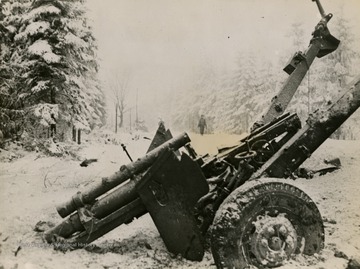
- IDNO:
- 041161
- Title:
- Blasted Gun in Snow Swept Belgium; Manhay, Belgium
- Date:
- ca. 1945
- Description:
- Information included on back: "A wrecked 105mm gun stands by the side of a road near Manhay, Belgium, where troops of the 83rd U.S. Infantry Division are advancing against the northern flank of the Nazi wedge. Manhay was wrested from enemy control December 28, 1944, by Allied forces driving toward the German St. Vith-Laroche supply road which was severed in several places by January 8, 1945, when 15 miles of the vital highway was under U.S. and British control. The Germans were thus left with only one major supply highway into their salient." (U.S. Signal Corps).
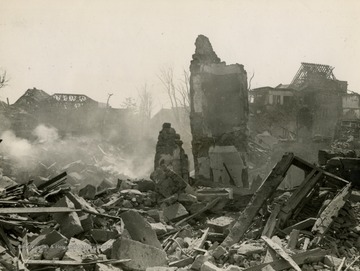
- IDNO:
- 041162
- Title:
- SAAR Town Destoryed By U.S. Advance, Zweibrucken, Germany
- Date:
- ca. 1945
- Description:
- Information on back of picture is torn, but partial info reads: "This is a scene in Zweibrucken, hammered by Allied air and U.S. artillery attacks before Seventh U.S. Army troops captured the town March 20, 1945."
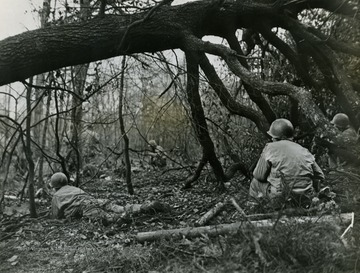
- IDNO:
- 041163
- Title:
- Soldiers Taking Cover During Battle of Hurtgen Forest Near Belgian-German Border
- Date:
- ca. 1945
- Description:
- A series of intense battles were fought here between the U.S. and German force from 1944/09/19 to 1945/02/10, over barely 50 sq mi. east of the Belgian–German border.
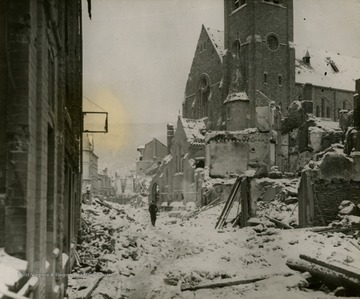
- IDNO:
- 041164
- Title:
- Belgian Civilian Moves Through Rubble, Laroche, Belgium
- Date:
- ca. 1945
- Description:
- Information on back of picture reads: "A civilian picks his way through the rubble littering the streets of Laroche, Belgium, formerly an important enemy communications center on the northern flank of the Ardonnes Salient. Supreme Headquarters Allied Expeditionary Force announced January 12, 1945, that Allied troops had taken the Belgian town. Only a little over a month after the launching of the unsuccessful Nazi counter-thrust December 16, 1944, front lone correspondents made it clear by midnight January 22, 1945, that the Battle of the Ardonnes was practically over."

- IDNO:
- 041165
- Title:
- German Civilians Seek Shelter, Tenholz, Germany
- Date:
- ca. 1945
- Description:
- Caption on back of photo reads: "German civilians from the small farming community of Tenholz are received by an American soldier in a shattered house serving as a reception center in Lovenich. The 102nd Infantry Division of the Ninth U.S. Army captured Lovenich February 25, 1945."
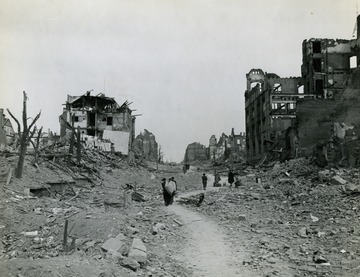
- IDNO:
- 041166
- Title:
- Destruction of Plauen, Germany
- Date:
- ca. 1945
- Description:
- Caption on back reads "Civilians of Plauen, Germany, make their way through rubble filled streets in search of what articles they can salvage from their wrecked homes and shops. The city was captured by the 3rd U.S. Army following a devastating attack by Allied bombers."
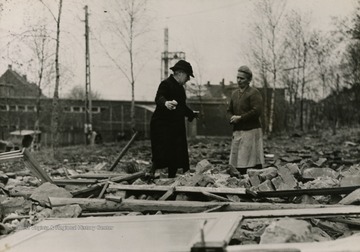
- IDNO:
- 041167
- Title:
- German Shell Causes Casualties in Reich, Germany
- Date:
- ca. 1945
- Description:
- Caption on back of photo reads: "German woman (left) stands before the wreckage of her home and explains to a neighbor how a heavy Nazi shell leveled the building. Several civilians were injured by the enemy action against the town after its capture by American troops."
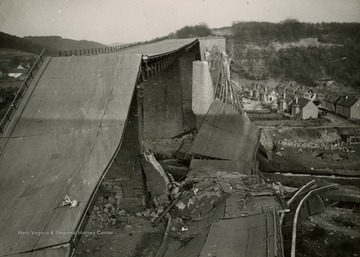
- IDNO:
- 041168
- Title:
- Germans Blow Up Autobahn Bridge, Kaiserslautern, Germany
- Date:
- ca. 1945
- Description:
- Information on back of photo reads: "This bridge, part of the German autobahn highway near Kaiserslautern, was blown up by fleeing Nazi troops during the advance of American forces inside the Saar bulge. Kaiserslautern, road junction town in the area, was entered by the Third U.S. Army troops March 20, 1945. The autobahn is the many-laned concrete highway designed to link up most of Germany in a network. The system had not been entirely completed by the Nazis at the outbreak of the war."
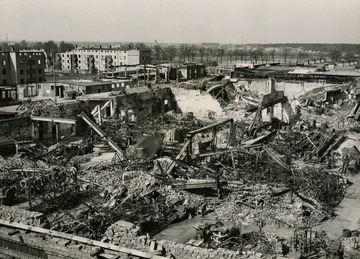
- IDNO:
- 041169
- Title:
- German Tire Plant Reduced to Rubble, Hanau, Germany
- Date:
- ca. 1945
- Description:
- Information on back of photo reads: "Rubble and bombed out buildings are all that remain of the plant of the Dunlop Company at Hanau, which was Germany's second largest tire plant. This factory specialized in aircraft tired before it was mombed out of existence by Allied air attacks. Twenty-eight miles east of the Rhine and eight miles east of Frankfurt, Hanau was cleared by troops of the Third U.S. Army March 27,1945."

- IDNO:
- 041170
- Title:
- Civilians Leave Aachen, Germany
- Date:
- ca. 1945
- Description:
- Information on back of photo reads: "Clutching a few personal belongings, German civilians pass through the blazing streets of Aachen en route to the safety of First U.S. Army lines. Most of the 3,000 civilians who managed to leave the Reich border city by October 14, 1944, were old men, weeping women, and children. American bombs and shells began turning Aachen into a blazing inferno when the surrounded Nazi garrison refused to surrender under penalty of destruction of the city."
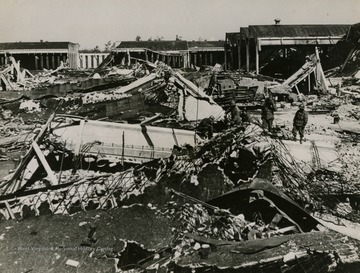
- IDNO:
- 041171
- Title:
- Allied Air Attacks Knock Out Nazi War Plant, Fallersleben, Germany
- Date:
- ca. 1945
- Description:
- Information on the back of photo reads: "This is all that remained of the famous Nazi Volkswagen factory at Fallersleben, Germany, when U.S. Army ground forces captured the town following four daylight attacks on the plant by bombers of the Eighth U.S. Air Force and the British Royal Air Force. Prior to the attacks, 18,000 employees worked here but this figure fell to 7,000 after the first Allied visits. Later, work in the factory came to a complete halt. Only 40 workers were killed during the bombings because of air raid shelters. The plant was originally built by the Deutsche Arbeiter Front (German Labor Part) in 1938-39 to produce the "people's car", or Volkswagen, for sale to the German people at about 900 marks ($360). After it was completed, the German High Command converted it to jeep and mine production. Before the Allied air attacks, the plant was capable of monthly production of 1,800 kubelwagen (jeeps), 1,000 amphibious jeeps, 1,200 V-1 bombs, 100,00 Teller mines and the repair of 30 Ju-88 aircraft wings."